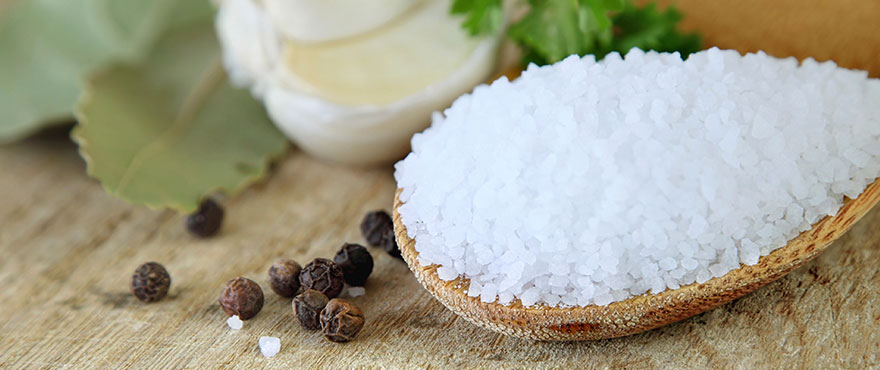
Lower Your Sodium Intake Naturally
Sodium also works closely with potassium to maintain normal fluid, or water, balance in the body. While some sodium is needed for health, getting too much may have negative health consequences.
According to the Canadian Community Health Surveys, most Canadians are getting more sodium than they need for general health purposes; about 3,400 mg per day on average although the actual intake may be higher since participants in the health surveys reported their sodium intake, it wasn’t measured. It’s estimated that men get more sodium than women with men between the ages of 14 and 30 consuming over 4,000 mg per day.
The concern about excess sodium consumption is that it may increase the risk for chronic diseases such as high blood pressure, and be a significant risk factor for stroke, and heart and kidney disease, in others. Higher sodium intakes have also been associated with a greater risk for osteoporosis.
How much do we need?
The ideal sodium intake is unknown but Health Canada’s current recommendations are to limit sodium from all sources to 2,300 mg per day; an amount that is achievable with some conscientious choices although it’s not without its challenges. This is because the majority of the sodium we get, about 77–80%, comes from prepared and processed foods; an amount that is beyond the consumers’ control because it’s the food manufacturers who are adding it.
Sodium that is naturally occurring in foods accounts for another 12% of our total intake with the balance coming from the salt that is added at the table (6%) and what’s added to food during cooking (5%). It’s estimated that 85% of men between the ages of 19 and 70 exceed the recommended upper level of 2,300 mg per day and 60% of women in the same age group do so as well.
Lowering your sodium naturally
Reducing sodium is much easier than one thinks. Without needing to count milligrams of sodium, a few substitutions can also help move the average Canadian in the right direction. Loaded with fresh ingredients and low in sodium, this Asian Chicken Shrimp & Wild Rice Soup has 50% of the Daily Value for vitamin B12 and is an excellent source of iron, vitamins C, B6, magnesium and zinc.
Tips to reduce your sodium include:
- Read ingredient lists. If the word ‘sodium’ is in the first five ingredients or listed more than once, the product may be high in sodium
- Use the %DV (Daily Value) on the Nutrition Facts Table and choose products that have less than 10% for sodium per serving. Pay attention to what a serving size is in order to keep your sodium intake lower
- Look for prepared foods labelled “salt-free’, “no salt added”, “low in sodium”, or “reduced in sodium”. These will have lower amounts of sodium compared to their regular non-sodium reduced counterparts
- Choose fresh, unprocessed foods more often
- Limit deli meats and choose fresh meats, such as chicken, fish and beef which are naturally low in sodium, more often
- Use condiments sparingly and look for lower-sodium versions
- Flavour foods with lemon juice, fresh and dried herbs and spices and flavoured vinegars
- Try lower-sodium seasoning mixes
- Limit ‘instant’ foods like noodles and hot cereals
- Choose fresh or frozen vegetables instead of canned
- Rinse canned foods like beans, lentils and even tuna under running water for 60 seconds
- Plan meals at least a day in advance to help reduce being crunched for time and getting takeout.
- Limit how often you choose fast foods
- Enjoy unsalted nuts and seeds
Try these tasty low-sodium recipes:
Apple Cider Poached Chicken & Arugula Salad delivers a lot of flavour without the need for much salt.
This African Peanut Chicken Stew has only 410 mg of sodium per serving and 44% of the Daily Value for magnesium.
Try these Almond Crusted Chicken Fingers with Sweet Potato ‘Plum’ Sauce for a hint of sweetness and very little sodium.
Low in calories and sodium but big on taste, this Asparagus & Chicken Soup with Asiago Cheese and Lemon makes a great first course.
There’s no denying that Canadians are getting more sodium than they need for good health. There’s also no doubt that processed and prepared foods are the greatest contributor to our sodium intake but reducing how much we get is easy once you know how. By taking the time to look for lower sodium options, using more fresh and dried herbs and spices, and eating more fresh foods like vegetables, fruit, and meats like chicken, moving from an average daily intake of 3,400 mg to below the upper level of 2,300 mg per day is not only doable, but painless.
References
- Health Canada. Sodium in Canada. Available online at: https://www.canada.ca/en/health-canada/services/food-nutrition/healthy-eating/sodium.html
- Health Canada. Dietary Reference Intakes (DRIs). Questions & Answers. Available online at: https://www.canada.ca/en/health-canada/services/food-nutrition/healthy-eating/dietary-reference-intakes/questions-answers.html
- Sodium 101. Get the Facts! Available online at: http://www.sodium101.ca